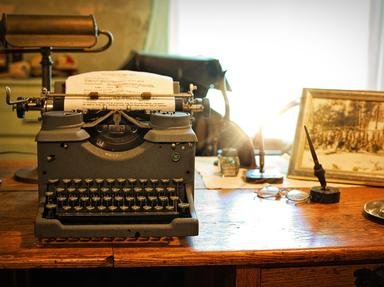Quiz Answer Key and Fun Facts
1. In the Preston/Child book "Thunderhead", I learned the name of the poison in Monkshood, sometimes known as Wolfsbane or Friar's Cap. I would never have realized it was a poison, since I'd never heard of it before and it doesn't sound like one. Do you know what it is?
2. In the Preston/Child book "Riptide", I learned the name of the German who wrote the first printed book on cryptology, "Polygraphiae", that was published in 1518. Can you guess who he is? This is a HARD one!
3. During the Victorian era "Cabinets of Curiousities" were popular, and that is the title of the next Preston/Child book I read. In it I learned that one specific person had a Cabinet of Curiousities that included not only the usual natural history specimens and cultural examples; he added live human and animal exhibits. At the age of 61 he began touring the country with his strange museum, for that's really what "Cabinets of Curiousities" were, individual museums. His was different because of the live exhibits. Who was he?
4. In Steve Berry's "The Amber Room", he repeats a quote: "Revenge is always the delight of a little weak and petty mind; of which you may straightway draw proof from this, that no one so rejoices in revenge as a woman". Who originally wrote this?
5. In the Preston/Child book "Brimstone", I read about a French Baroque painter of whom I had not known, who specialized in religious chiaroscura paintings, that were lit only by candle light. Do you know him?
6. In "Cemetery Dance", Preston and Child tell us what tribe it was from whom Peter Minuit bought Manhattan. Do you know what one it was?
7. Also from "Cemetery Dance" comes this question. In what part of a city in the eastern part of the United States is the Shorakkopoch Monument?
8. In the Preston/Child novel, "Fever Dream", we are told that John James Audubon, spent some time as the tutor for the daughter of the well-to-do owner of Oakley Plantation. In what town in Louisiana can you still find Oakley Plantation?
9. In the Preston/Child novel "Book of the Dead", I learned who actually found the Rosetta Stone. It was a surprise since his name wouldn't have entered my mind if someone had asked me. Do you know whose men found it?
10. From the Preston/Child "Book of the Dead", I learned where the headquarters of Ferragamo, the Italian luxury goods company, was located. Do you know?
Source: Author
habitsowner
This quiz was reviewed by FunTrivia editor
looney_tunes before going online.
Any errors found in FunTrivia content are routinely corrected through our feedback system.

